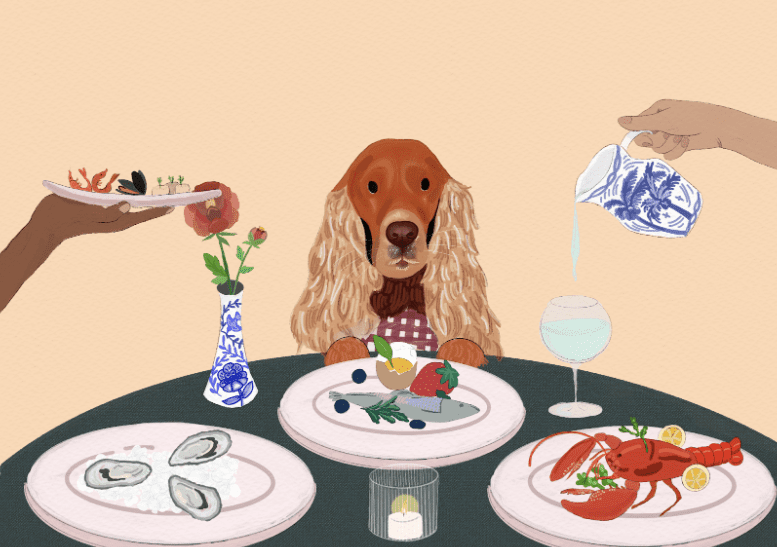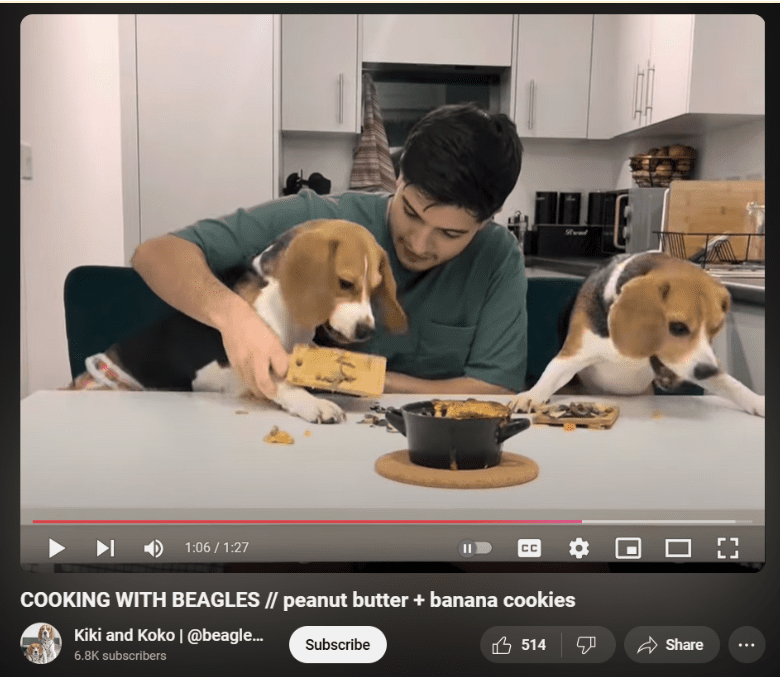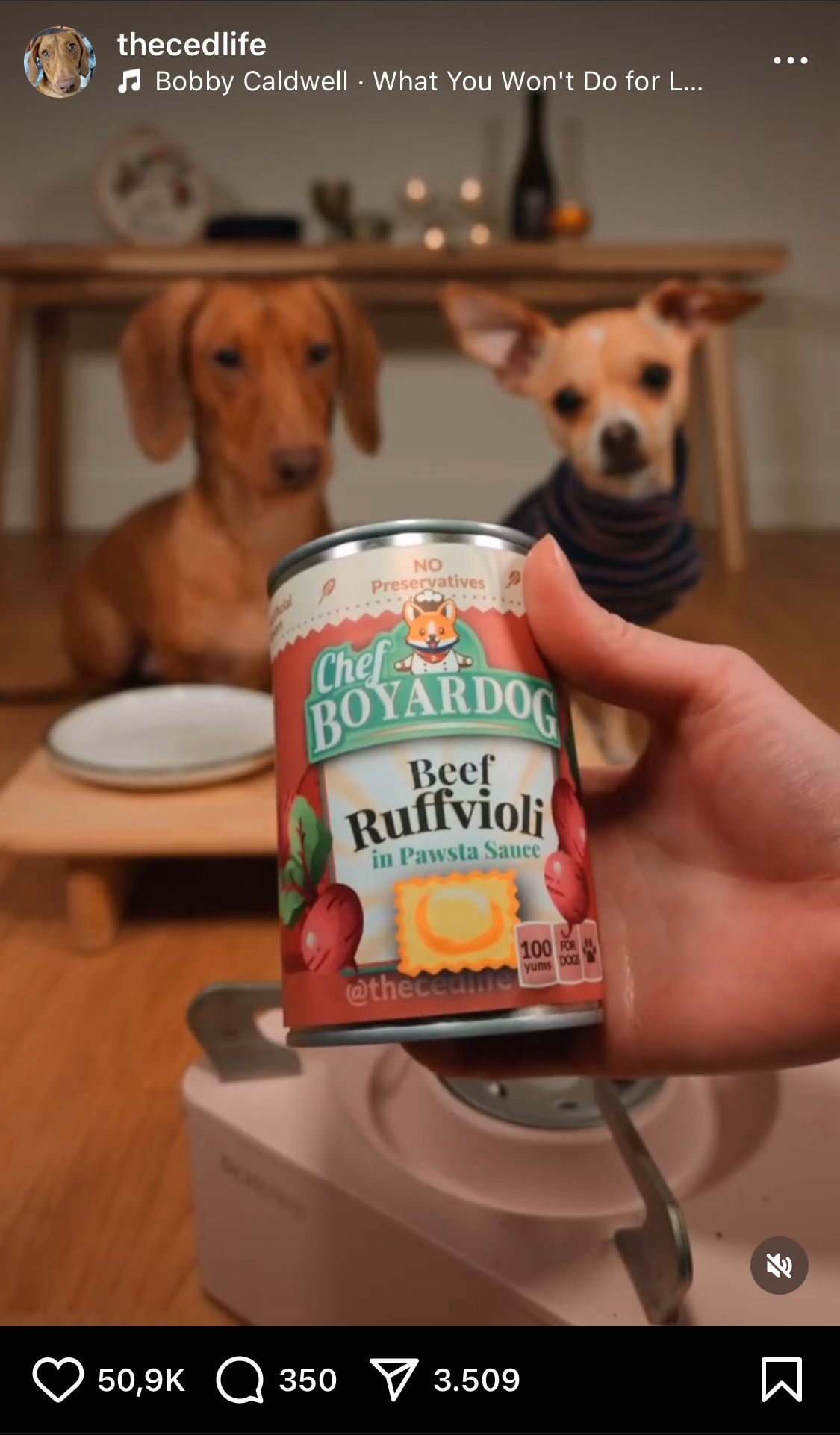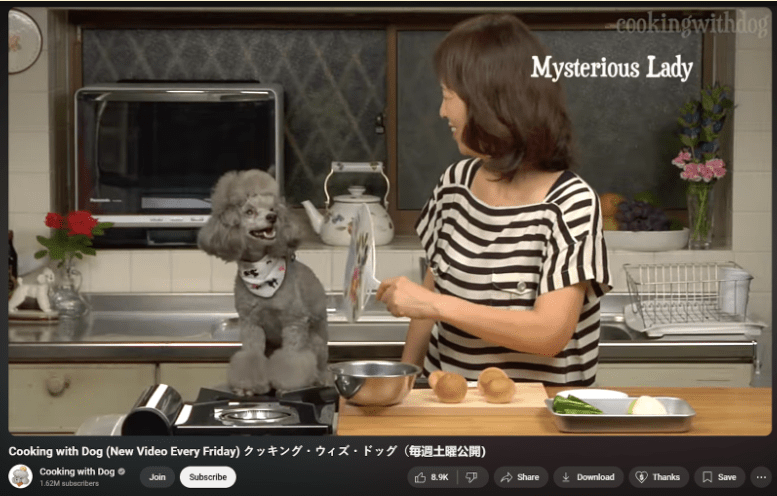Meaningful Mealtimes
Human and nonhuman lives may have first become closely entangled with the rise of agriculture as we raised both animals to eat and other animals that could help us manage the animals we raised to eat. However, the relationality between humans and animals has expanded beyond such survivalist functions. Today, we share our homes and, as we will discuss in this post, our food and eating practices with them as valued members of more-than-human families, co-participating and co-producing our complex and ever-evolving cultures surrounding food.
Eating provides opportunities of sharing and relating to people, places, and ideas (Simmel 1997; Sobal 2000). The foods that we eat are embedded with several contextual and situational cues: the ingredients involved, how they’re prepared, and how they are eaten are all signs of our positionalities. Eating with others, or commensality, has been widely interrogated by the field of food studies, with strong roots in anthropology. Eating matters because we learn about ourselves and others while doing it. Mealtimes become sites of exchange and connection, regardless of the setting—at a university, a workplace canteen, or a festive family feast. We learn how people think, behave, and orient themselves to the world and society. These are also shaped by intersectionality of contexts and identities such as age, gender, race, ethnicity, and more. One might be served first, be offered more food, or experience a brush of competitive culinary nationalism upon the first bite. It is for this reason that eating and mealtimes are seen as social scripts (Van Der Heijden and Wiggins 2024).
Take etiquette books, published instructions which guide people on how to be “respectable” members of society. Within European and Anglo-American etiquette, there are several rules on eating: from how to set the table, to how much you should eat, and how you should do it.[1] Surprisingly, these texts also extend to other species—namely, domesticated animals like dogs and cats. The Emily Post Institute, an authority on social etiquette, urges dog owners to beware feeding dogs “human food” and be cautious about them disrupting your dining guests’ eating experiences (Joskowitz 2022). This strangely disregards the longstanding history of humans dining with our dogs—a perusal through most art galleries’ paintings would reveal that quickly. In several paintings dogs are seen accompanying their humans as they eat their meals, either eating from their own bowls at the foot of the table or excitedly waiting for scraps. In the classic Disney film, “The Lady and the Tramp,” the two starring dogs share a plate of spaghetti atop a table-clothed box with romantic candlelight in an alleyway.

An Esteemed Dinner Guest (Drawn by the author Maythe Han)
However, this warm and fuzzy fantasy of kinship does not extend to all domesticated animals. Rather, it reinforces an ongoing hierarchy that dictates which animals are seen as worthy of such relationalities and which aren’t. We see this quite acutely when we think about which animals we enthusiastically find edible or tasty—as George Orwell declared in his book Animal Farm, “all animals are created equal, but some are more equal than others” (Orwell 1945). Animals are somehow expected to adhere to human etiquette around foods, while simultaneously being positioned either as food and or unworthy of “human” foods.
Within an evolving global food system, sturdy supply chains have given us access to many types and larger amounts of food. We are able to have them whenever we want them, from whichever kinds of places and animals we see fit. Despite this, issues of food security and under- and over-nutrition persist. Coupled with increasing work demands and decreasing free time, we find ourselves (mostly) eating alone in constrained time slots, perhaps in our cubicles or offices. In response, movements which encourage “slowing down” and eating more mindfully have resurged. Rising amounts of local organic food markets, the revalorisation of home-cooking, the recognition of the importance of commensality, and attention to food waste demonstrate this. Eating means something—many things. Eating with our non-human kin expands these registers of meaning surrounding food across species boundaries.
A Place at the Table and in the Kitchen
Over the last decade, there has been a sharp rise in the creation and sharing of online food content. Nowadays virtual grocery lists, online recipe blogs, and dedicated videos are commonplace. This “digital colonisation of food”—the process by which digital technologies, devices, and services have populated and overtaken everyday food choices and decision-making—showcases how the culinary and alimentary mundanity of everyday life have become the focus of entertainment and interest to many (Lewis 2018). Bringing animals to the table and kitchen has been a prominent trope within online food, cooking, and eating videos, as shown below.

Screenshot of a @BeaglesKiko YouTube video series “Cooking with Beagles” (Screenshot by the Authors, Credit to BeaglesKiko)
Animals at the table (and in the kitchen) provide companionship, support, and most importantly, unfiltered feedback. Animals’ reactions to a prepared meal are direct, simply because the social scripts in which we ascribe and project upon them are our own (Spunt et al. 2016). While we can observe and recognise some perceived parallels in how animals respond to cooking and mealtimes, it is impossible to know what they are truly thinking. If anything, our animal kin are reflections of different ideas, values, and beliefs that we have about food. We like to think of our animal kin as freer than us, leaning into understandings of untamed wild-ness where the social scripts to which we are bound do not apply (Berland 2019, p.106).
For online creators and influencers, being a micro-celebrity generates possibilities for personal branding and re-invention (Song 2018). As a creator, it’s necessary to establish and evolve one’s niche in order to please and maintain dynamic reactive online audiences, as media landscapes and trends move quickly (Arriagada and Ibáñez 2020). By bringing our animals to our social media, we extend this responsibility to them—as co-creators and fellow micro-celebrities—facilitating media content innovations. Animals on food eating and cooking media take leading roles, acting as hosts (e.g., Francis on Cooking with Dog) and mascots (e.g. the beagles, Kiki and Koko), constituting public-facing symbols. The animals who gather, cook, and eat foods with their humans become intermeshed within a cornucopia of ascribed values and meanings that we curate, eventually developing social taste and preferences through the culinary exposures we share with them. These dogs, like us, eat festively for the holidays, crave decadently sweet desserts, and long for an elaborate cocktail or two.

Instagram User @TheCedLife shows her dogs Cedric and Edith a can of Chef Boyardog (Screenshot by the Authors, Credit to @TheCedLife)
Instagram user @thecedlife regularly posts videos of her cooking her favourite dishes for her two dogs, Cedric and Edith. Each video swaps out specific ingredients for dog-safe ones, accompanied by punny references to common food brands and products reimagined. Fruit loops cereal appear as “Pooch Loops,” canned Chef Boyardi ravioli are “Chef Boyardog ruffivioli,” and a cyan blue bottle of Bombay Sapphire gin sparkles as “Bombark Sapphire.” Whatever @thecedlife feels like eating, she extends it to her doggie companions—Chinese mooncakes, full English breakfasts, fried Spam (technically SPUP) from a can, tteokbokki in scarlet bubbling sauce. Both Cedric and Edith, as dining companions, are able to reflect and expand upon their owner’s conceptions of “good” food taste. Theorising dogs’ food preferences and eating choices has been historically tackled through mainly biological and chemical approaches. Comparatively, ongoing research on the hedonistic interest and eating pleasure of dogs has been growing to include additional sensorial factors like odor and visuality (Hall et al. 2017). Food media of dining and cooking with dogs further reveals the shared interspecies practice of pleasurable and meaningful eating by our canine companions.
Aside from being esteemed guests, dogs also cook. YouTube user “Cooking with Dog” models her channel off this premise; alongside grey poodle Francis, the delegated host of the show, the two prepare several characteristically Japanese dishes. Within each video, we learn more about common traditional Japanese food dishes, while soaking up charismatic insights provided by Francis through voiceovers—here we have a bit of interspecies food nationalism and gastrodiplomacy (Ichijo et al. 2019, White et al. 2019) .

A screenshot of the YouTube “Cooking with Dog” (Screenshot by Authors, Credit to Cooking With Dog)
More-than-Human Culinary Connections
So what do social media videos of people dining with or cooking with their nonhuman kin mean within the context of being human and interspecies relations? Well, a lot of things. Firstly, it reiterates the extensive intimacy we share and encourage across both mealtimes and social media content creation. We are sure of our bonds with the animals in our lives, and being able to demonstrate that to online viewers and outwardly express that as part of our social and creator identities consolidates the kinship that humans and nonhumans produce and reproduce through materials, processes, and practices involving food. In turn, the mundanity of everyday life becomes transformed into an online spectacle of sorts that reinforces the connections that digital platforms enable, including influencer culture and micro-celebrity status, for both humans and nonhumans.
Secondly, it highlights the absolute centrality of nonhuman animals and their role on the internet that humans so heavily use and rely on today. As they say, “the internet was created for cat videos”—but of course, the same could be said for dogs. Videos of animals and food are widely available, transcend language barriers, and transcend human social norms that concern food and eating. For example, common critiques of the mukbang genre such as the glorification of obesity do not apply towards animals who perform mukbang (think: Garfield and his endless hunger for lasagnes in bulk, which is perceived as humorous rather than as a health risk). Animals in the media can thus eat messily, in whatever amount and frequency they desire—chewing with mouths wide is not only expected and accepted, but celebrated. The appeal of animal cuteness propels this further, generating an imaginary where animals are absolved from surrounding food-related social expectations within the contexts in which they are embedded because of their perceived playfulness and infantility (Dydynski 2018). These videos have their benefits beyond entertainment. Research has noted that cute animal videos are known to help humans with reducing stress by promoting relaxation, helping with mood regulation, and providing support for emotional issues, thus contributing to overall health and well-being (Myrick 2015, Johnson et al. 2023, Lavan et al. 2023). Given that eating with dogs provides several of the supports and comforts as eating with other humans does, expanding the boundaries around the benefits of commensality beyond the species border is a logical step. Doing so may lead to expanded conversations and the combating of eating alone, which has notable health deficits like over-eating, making poor eating choices, and increased instances of loneliness which actively deteriorates physical and mental well-being (NASEM 2020, Björnwall et al. 2024). If eating is healing, then eating with dogs is also healing.
Notes
[1] There are definitely different etiquettes across the globe, but this piece highlights specifically Emily Post’s writings on etiquette. Post was an Anglo-American “socialite” in the early 20th century who drew primarily from European social norms and practices, adjusting them for American audiences.
References
Arriagada, A., Ibáñez, F., 2020. “You Need At Least One Picture Daily, if Not, You’re Dead”: Content Creators and Platform Evolution in the Social Media Ecology. Social Media + Society 6, 2056305120944624. https://doi.org/10.1177/205630512094462
Berland, J. (2019). Virtual Menageries: Animals as Mediators in Network Cultures, Cambridge, MA: MIT Press.
Björnwall, A., Colombo, P.E., Sydner, Y.M., Neuman, N., 2024. The impact of eating alone on food intake and everyday eating routines: A cross-sectional study of community-living 70- to 75-year-olds in Sweden. BMC Public Health 24, 2214. https://doi.org/10.1186/s12889-024-19560-0
Dydynski, J., 2018. Multisensory perception of cuteness in mascots and zoo animals.
Foer, J. S. (2010). Eating animals. 1st Back Bay pbk. ed. New York, Back Bay Books/Little, Brown and Co.
Hall, N.J., Péron, F., Cambou, S., Callejon, L., Wynne, C.D.L., 2017. Food and Food-Odor Preferences in Dogs: A Pilot Study. Chemical Senses 42, 361–370. https://doi.org/10.1093/chemse/bjx016
Ichijo, A., Johannes, V., Ranta, R., (2019). The Emergence of National Food: The Dynamics of Food and Nationalism. Bloomsbury.
Johnson, E. A., Survase, S., & Gray, P. B. 2023. Examining the Impact of Virtual Animal Stimuli on College Students’ Affect and Perception of their Academic Advising Experience. Animals : an open access journal from MDPI, 13(9), 1522. https://doi.org/10.3390/ani13091522
Joskowitz, L. 2022. The Ultimate Holiday Petiquette Guide: For Hosts and Guests. Chewy Magazine. https://be.chewy.com/emily-post-holiday-petiquette/
Lavan, S., Ein, N. and Vickers, K. (2023) ‘Examining the Effects of Nature and Animal Videos on Stress’, Anthrozoös, 36(5), pp. 849–868. doi: 10.1080/08927936.2023.2210439.
Lewis, T., & Phillipov, M. (2018). Food/media: eating, cooking, and provisioning in a digital world. Communication Research and Practice, 4(3), 207–211. https://doi.org/10.1080/22041451.2018.1482075
Myrick, J.G., 2015. Emotion regulation, procrastination, and watching cat videos online: Who watches Internet cats, why, and to what effect? Computers in Human Behavior 52, 168–176. https://doi.org/10.1016/j.chb.2015.06.001
National Academies of Sciences, Engineering, and Medicine (NASEM). 2020. Health Impacts of Social Isolation and Loneliness on Morbidity and Quality of Life. Washington (DC): National Academies Press (US).: https://www.ncbi.nlm.nih.gov/books/NBK557983/
Orwell, George. 1945. Animal Farm. Secker & Warburg.
Simmel, G., 1997. The sociology of the meal.
Sobal, J., 2000. Sociability and meals: Facilitation, commensality, and interaction. Dimensions of the meal: The science, culture, business, and art of eating, 2000, pp.119-33.
Song, H., 2018. The Making of Microcelebrity: AfreecaTV and the Younger Generation in Neoliberal South Korea. Social Media + Society 4, 205630511881490. https://doi.org/10.1177/2056305118814906
Spunt, R., Ellsworth, E., and Adolphs, R. 2016. The neural basis of understanding the expression of the emotions in man and animals. Soc Cogn Affect Neurosci. Nov 1;12(1):95–105. doi: 10.1093/scan/nsw161
Van Der Heijden, A., Wiggins, S., 2024. Interaction as the foundation for eating practices in shared mealtimes. Appetite 107585. https://doi.org/10.1016/j.appet.2024.107585
White, W., Barreda, A.A., Hein, S., 2019. Gastrodiplomacy: Captivating a Global Audience Through Cultural Cuisine-A Systematic Review of the Literature. Journal of Tourismology 5(2), 127-144. https://ideas.repec.org/a/ist/iupjot/v5y2019i2p127-144.html
